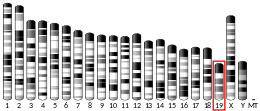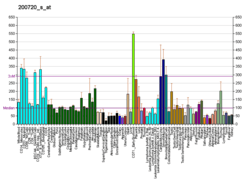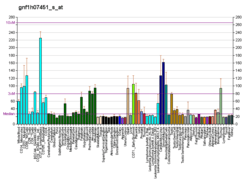ACTR1A
Alpha-centractin (yeast) or ARP1 is a protein that in humans is encoded by the ACTR1A gene.[5][6]
Function
This gene encodes a 42.6 kD subunit of dynactin, a macromolecular complex consisting of 10-11 subunits ranging in size from 22 to 150 kD. Dynactin binds to both microtubules and cytoplasmic dynein. It is involved in a diverse array of cellular functions, including ER-to-Golgi transport, the centripetal movement of lysosomes and endosomes, spindle formation, chromosome movement, nuclear positioning, and axonogenesis. This subunit is present in 8-13 copies per dynactin molecule, and is the most abundant molecule in the dynactin complex. It is an actin-related protein, and is approximately 60% identical at the amino acid level to conventional actin.[6] ARP1 forms a 37 nm filament-like structure and is the core of the dynactin complex.[7] It only exists in the dynactin complex in vivo. Highly purified, native Arp1 polymerize rapidly at extremely low concentrations into short filaments in vitro that were similar, but not identical, in length to those in dynactin. With time, these Arp1 filaments appeared to anneal to form longer assemblies but never attained the length of conventional actin filaments. As for conventional actin, Arp1 can bind and hydrolyze ATP, and Arp1 assembly is accompanied by nucleotide hydrolysis.[8]
It has been reported that Arp1 interacts with other dynactin components including DCTN1/p150Glued,[9]DCTN4/p62[10][11] and Actr10/Arp11.[12] Arp1 has been shown as the domain for dynactin binding to membrane vesicles (such as Golgi or late endosome) through its association with β-spectrin.[13][14][15][16]
References
- GRCh38: Ensembl release 89: ENSG00000138107 - Ensembl, May 2017
- GRCm38: Ensembl release 89: ENSMUSG00000025228 - Ensembl, May 2017
- "Human PubMed Reference:". National Center for Biotechnology Information, U.S. National Library of Medicine.
- "Mouse PubMed Reference:". National Center for Biotechnology Information, U.S. National Library of Medicine.
- Lees-Miller JP, Helfman DM, Schroer TA (Oct 1992). "A vertebrate actin-related protein is a component of a multisubunit complex involved in microtubule-based vesicle motility". Nature. 359 (6392): 244–6. Bibcode:1992Natur.359..244L. doi:10.1038/359244a0. PMID 1528266.
- "Entrez Gene: ACTR1A ARP1 actin-related protein 1 homolog A, centractin alpha (yeast)".
- Schafer DA, Gill SR, Cooper JA, Heuser JE, Schroer TA (1994). "Ultrastructural analysis of the dynactin complex: an actin-related protein is a component of a filament that resembles F-actin". The Journal of Cell Biology. 126 (2): 403–412. doi:10.1083/jcb.126.2.403. PMC 2200042. PMID 7518465.
- Bingham JB, Schroer TA (1999). "Self-regulated polymerization of the actin-related protein Arp1". Curr. Biol. 9 (4): 223–6. doi:10.1016/S0960-9822(99)80095-5. PMID 10074429.
- Waterman-Storer CM, Karki S, Holzbaur EL (1995). "The p150Glued component of the dynactin complex binds to both microtubules and the actin-related protein centractin (Arp-1)". Proc. Natl. Acad. Sci. U.S.A. 92 (5): 1634–8. Bibcode:1995PNAS...92.1634W. doi:10.1073/pnas.92.5.1634. PMC 42574. PMID 7878030.
- Garces JA, Clark IB, Meyer DI, Vallee RB (1999). "Interaction of the p62 subunit of dynactin with Arp1 and the cortical actin cytoskeleton". Curr. Biol. 9 (24): 1497–500. doi:10.1016/S0960-9822(00)80122-0. PMID 10607597.
- Karki S, Tokito MK, Holzbaur EL (2000). "A dynactin subunit with a highly conserved cysteine-rich motif interacts directly with Arp1". J. Biol. Chem. 275 (7): 4834–9. doi:10.1074/jbc.275.7.4834. PMID 10671518.
- Eckley DM, Schroer TA (2003). "Interactions between the evolutionarily conserved, actin-related protein, Arp11, actin, and Arp1". Mol. Biol. Cell. 14 (7): 2645–54. doi:10.1091/mbc.E03-01-0049. PMC 165665. PMID 12857853.
- Holleran EA, Tokito MK, Karki S, Holzbaur EL (1996). "Centractin (ARP1) associates with spectrin revealing a potential mechanism to link dynactin to intracellular organelles". J. Cell Biol. 135 (6 Pt 2): 1815–29. doi:10.1083/jcb.135.6.1815. PMC 2133946. PMID 8991093.
- Holleran EA, Ligon LA, Tokito M, Stankewich MC, Morrow JS, Holzbaur EL (2001). "beta III spectrin binds to the Arp1 subunit of dynactin". J. Biol. Chem. 276 (39): 36598–605. doi:10.1074/jbc.M104838200. PMID 11461920.
- Muresan V, Stankewich MC, Steffen W, Morrow JS, Holzbaur EL, Schnapp BJ (2001). "Dynactin-dependent, dynein-driven vesicle transport in the absence of membrane proteins: a role for spectrin and acidic phospholipids". Mol. Cell. 7 (1): 173–83. doi:10.1016/S1097-2765(01)00165-4. PMID 11172722.
- Johansson M, Rocha N, Zwart W, Jordens I, Janssen L, Kuijl C, Olkkonen VM, Neefjes J (2007). "Activation of endosomal dynein motors by stepwise assembly of Rab7-RILP-p150Glued, ORP1L, and the receptor betalll spectrin". J. Cell Biol. 176 (4): 459–71. doi:10.1083/jcb.200606077. PMC 2063981. PMID 17283181.
- Mao B, Wu W, Li Y, Hoppe D, Stannek P, Glinka A, Niehrs C (2001). "LDL-receptor-related protein 6 is a receptor for Dickkopf proteins". Nature. 411 (6835): 321–5. Bibcode:2001Natur.411..321M. doi:10.1038/35077108. PMID 11357136.
Further reading
- Clark SW, Meyer DI (1992). "Centractin is an actin homologue associated with the centrosome". Nature. 359 (6392): 246–50. Bibcode:1992Natur.359..246C. doi:10.1038/359246a0. PMID 1356230.
- Clark SW, Staub O, Clark IB, et al. (1995). "Beta-centractin: characterization and distribution of a new member of the centractin family of actin-related proteins". Mol. Biol. Cell. 5 (12): 1301–10. doi:10.1091/mbc.5.12.1301. PMC 301159. PMID 7696711.
- Faulkner NE, Vig B, Echeverri CJ, et al. (1998). "Localization of motor-related proteins and associated complexes to active, but not inactive, centromeres". Hum. Mol. Genet. 7 (4): 671–7. doi:10.1093/hmg/7.4.671. PMID 9499420.
- Heimann K, Percival JM, Weinberger R, et al. (1999). "Specific isoforms of actin-binding proteins on distinct populations of Golgi-derived vesicles". J. Biol. Chem. 274 (16): 10743–50. doi:10.1074/jbc.274.16.10743. PMID 10196146.
- Clark IB, Meyer DI (2000). "Overexpression of normal and mutant Arp1alpha (centractin) differentially affects microtubule organization during mitosis and interphase". J. Cell Sci. 112 (20): 3507–18. PMID 10504299.
- Saffery R, Irvine DV, Griffiths B, et al. (2000). "Human centromeres and neocentromeres show identical distribution patterns of >20 functionally important kinetochore-associated proteins". Hum. Mol. Genet. 9 (2): 175–85. doi:10.1093/hmg/9.2.175. PMID 10607828.
- Fouquet J, Kann M, Souès S, Melki R (2000). "ARP1 in Golgi organisation and attachment of manchette microtubules to the nucleus during mammalian spermatogenesis". J. Cell Sci. 113 (5): 877–86. PMID 10671377.
- Hartley JL, Temple GF, Brasch MA (2001). "DNA Cloning Using In Vitro Site-Specific Recombination". Genome Res. 10 (11): 1788–95. doi:10.1101/gr.143000. PMC 310948. PMID 11076863.
- Carew JA, Jackson AA, Bauer KA (2004). "ARP1 interacts with the 5' flanking region of the coagulation factor VII gene". J. Thromb. Haemost. 1 (6): 1220–7. doi:10.1046/j.1538-7836.2003.00227.x. PMID 12871323.
External links
- ACTR1A human gene location in the UCSC Genome Browser.
- ACTR1A human gene details in the UCSC Genome Browser.






